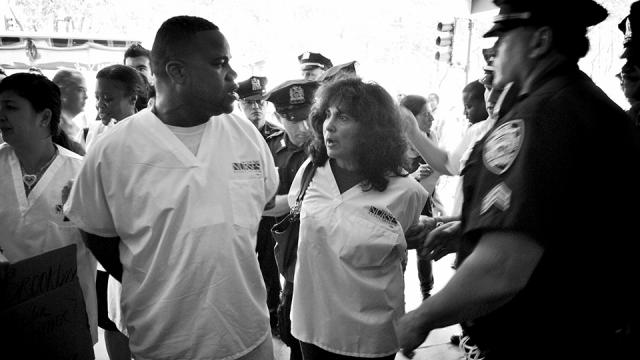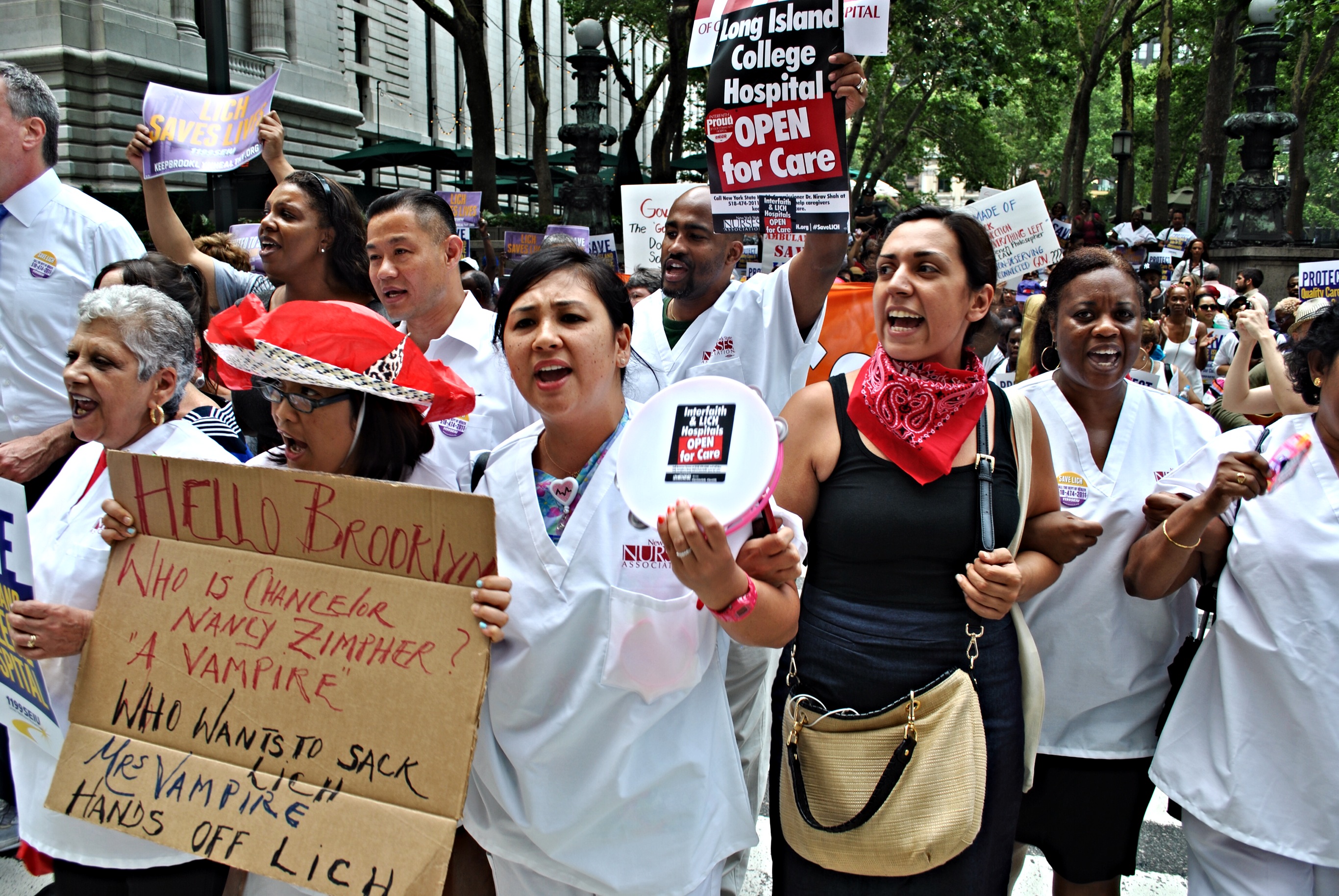
As the Affordable Care Act goes into effect, moves to close a 155-year-old hospital in downtown Brooklyn — and potentially sell it to a for-profit entity or a developer — could have national implications.
The partial shutdown of Long Island College Hospital (LICH), which caregivers and patients have fought to save for months, has already spawned a health crisis that some are comparing to Superstorm Sandy, which struck the city last year.
Ryan Schiavon, who works as a paramedic at LICH, says he's been forced by administrators to bypass the hospital and bring the patients he picks up to other facilities that are crowded stretcher-to-stretcher as a result.
"It's utter chaos,” says Schiavon. “It's stuff we haven't seen since Hurricane Sandy. It's getting back to that level.”
LICH is currently fully staffed with some 2,000 doctors, nurses, specialists and other employees working their regular shifts. But just over a dozen patients are inside. Empty beds abound.
“We had significant infrastructure problems that would cost probably anywhere from a quarter billion to half a billion dollars,” says Dr. John Williams, president of the State University of New York's (SUNY) Downstate wing, which runs LICH and two other hospitals in Brooklyn.
“So we made the recommendation that the institution be closed. As a result of that decision we started to see doctors leaving en mass. Now, we have an unsafe facility with only nineteen patients in it.”
But critics accuse SUNY of seeking to provoke a crisis at the hospital in order to justify selling the property.
“It's not that people are fleeing,” counters Geannie Segall, who has been a respiratory therapist for 23 years at LICH. “They've been thrown-out; they've been transferred out; they've been bullied out against their will. This has been an engineered crisis from the very beginning.”
Sean Petty with the New York State Nurses Association (NYSNA), which represents staff at LICH, says the university is attempting to maintain the profitability of its healthcare network as the Affordable Care Act gets implemented.
“The hospital industry is trying to restructure itself to take advantage of Obamacare changes and not be penalized by the changes,” says Petty. The Affordable Care Act will impose a 22% reduction in the payments hospitals receive for treating the uninsured, under the auspices that more patients will purchase insurance now mandated under the new law.
“There's all kinds of problems with this rationale. Many people still won't be able to afford insurance and will take the penalty instead, or if they are insured, they won't utilize it since the co-pays are so high,” he says.
Penalties will also increase under Obamacare for what the industry refers to as adverse outcomes, such as bedsore rates or rates of readmission. “Let's say you're a poorer hospital and you cut corners on care,” Petty says, “you'll then have to pay a five percent penalty on the total government reimbursement you receive.”
As a result, the industry is slimming down. Community hospitals like LICH are being closed or sold off, unionized workers laid off and clinics – cheaper to operate than large care-centers – are opening in their stead.
SUNY has released a Sustainability Plan that calls for “significant work force reductions” and service cuts across the healthcare network. Developers and private equity firms are circling above, ready to harvest the scraps. First up: LICH.
SUNY acquired the hospital in 2011 and in February, the university's Board of Trustees voted to close it, entertaining proposals to buy the deficit-laden hospital.
“They got a list of people who are open to taking over the facility,” said mayoral candidate Bill de Blasio, who currently holds the elected office of New York City Public Advocate. “Most of them are healthcare providers. One is a developer. We don't know who they are, we don't know the details of the proposals. For elected officials, for the community to work together to save LICH we need that information.”
The hospital's location, on high ground along Brooklyn's waterfront provided a refuge for those in low-income, dock neighborhood of Red Hook who were wounded when Superstorm Sandy swept on shore last autumn. But it also sits on high value real-estate in nearby Cobble Hill, making it a prime target for developers. In a solicitation for bids, SUNY boasts that the area surrounding LICH features “beautiful brownstones, a half-acre park and historic buildings that make the neighborhood a very desirable destination to live and work.”
“That doesn't sound like they are advertising the neighborhood as a site for healthcare,” said Assemblywoman Joan Millman, who was arrested for refusing to disperse from the SUNY Chancellor's office earlier this month, along with de Blasio and eight LICH nurses. “They're advertising the neighborhood as a site for luxury condos.”
Multiple hospitals in New York City have closed during the reign of Michael Bloomberg. In the most high-profile case, St. Vincent's was shutdown in 2010 and is now the site of a luxury apartment building that claims to provide residents with an experience “similar to a private members club.”
A corporate hospital company has also expressed interest in LICH. Though for-profit hospitals are currently barred from operating in New York State, lawmakers have put up measures that would begin to lift such prohibitions. In recent years, six Catholic hospitals in Boston were purchased by Cerberus Capital Management; in Detroit, Blackstone group took over eight failing not-for-profit care-centers. Many fear New York's healthcare system is next in line.
“New York is one of the last bastions of non-profit care” says Petty, “and a testing ground for how to break down regulatory barriers and enter one of the last healthcare markets left untapped.”
Caregivers and patients in Brooklyn have formed a vocal coalition to prevent LICH's closure see themselves as holding the line against attempts by the state to sell out — and by corporations to buy out — healthcare infrastructure. As they've rallied and conducted civil disobedience to keep the hospital open, courts have come to their aid.
NYSNA, citing the potential impact the closure would have on Brooklyn's healthcare network, sought and obtained a restraining order against SUNY following the February closure vote. However, in violation of the order, SUNY began diverting ambulances from the hospital on June 19, only admitting walk-in patients.
Illustrating the absurd lengths SUNY has gone to keep patients out, Geannie Segall says that when one of her co-workers collapsed near the hospital recently, instead of being taken directly inside the building and receiving treatment, he was driven off to another facility. “This is idiocy,” she says.
On Thursday, Segall and other LICH employees say they were given a verbal order to begin shipping bedridden patients elsewhere.
In one case, SUNY bought a bus ticket to Florida for an elderly man in its effort to clear out the hospital. The patient's ailment could not be disclosed because such details are confidential by law, but a LICH nurse who spoke on condition of anonymity said, in her opinion, it was unsafe for him to travel. “He's 84 years old. His primary language is Spanish. He speaks very little English.”
Aside from a receipt showing that SUNY purchased the bus ticket, the nurse also held a letter, written by administrators and given to the patient that began, “I need your help,” and listed his personal information and the details of his trip, presumably to hand to strangers in case he gets lost. When the elderly gentlemen had difficulties leaving the hospital and missed the bus, the nurse said SUNY purchased him a plane ticket instead.
On Friday, as the number of patients continued to dwindle inside LICH, a large crowd of doctors and nurses in hospital scrubs together with many LICH patients rallied outside.
“We are standing here with our fists raised to save our hospital,” said Schiavon dressed in his blue paramedic's uniform.
The crowd called on New York Governor Andrew Cuomo to intervene on their behalf. The governor failed to step in, however, and in what seemed like a crushing blow to those defending the hospital, SUNY released a letter from the state's Department of Heath, which Cuomo oversees, giving the university the go-ahead to bolt LICH's doors by July 29. Several of those involved in the months-long fight to salvage the hospital broke out in tears.
But, in an 11th hour legal twist, the State Supreme Court issued yet another restraining order against SUNY, this time brought by de Blasio.
Justice John Baynes barred the university “from taking any action or issuing any order that would interrupt, hamper or curtail” medical care at LICH and criticized SUNY over it's disregard for the court's previous ruling. The hospital has once again begun admitting walk-in patients, but ambulances are still bypassing the hospital. SUNY is due back in court on July 25.
A lot hangs in the balance. The university has expressed an eagerness to shutter another Brooklyn hospital it operates, Inter-Faith Hospital in Brooklyn's Flatbush neighborhood. Inter-Faith is next on the closure docket. If both carecenters close, it would leave a borough of 2.5 million people with just five emergency rooms.
Ryan Schiavon worries the diversion of ambulances and removal of patients from LICH, and the crisis it sparked, could be institutionalized in the future. “What should be unusual, what should be extreme is becoming the new normal,” he warns.
By standing together, caregivers and patients have so far beaten back the latest iteration of the austerity wave that continues to bear down on the city. The coalition that has formed to save LICH — featuring healthcare professionals and community members working together to pressure elected officials, hospital administrators and the courts to serve the interests of patients, not profits — might provide a blueprint for broader struggles activists wage going forward, not just in Brooklyn but across the country.
3 WAYS TO SHOW YOUR SUPPORT
- Log in to post comments


















